Unveiling theranostic potential: Insights into cell-free microRNA-protein interactions
IF 2.2
3区 生物学
Q2 BIOCHEMISTRY & MOLECULAR BIOLOGY
引用次数: 0
Abstract
MicroRNAs (miRNAs) belong to a short endogenous class of non-coding RNAs which have been well studied for their crucial role in regulating cellular homeostasis. Their role in the modulation of diverse biological pathways by interacting with cellular proteins, genes, and RNAs through cellular communication projects them as promising biomarkers and therapeutic targets. However, studying miRNA-protein interactions specific to disease in the extracellular or cell-free environments for drug discovery and biomarker establishment is challenging and resource-intensive due to their structural complexities. In this study, we present a computational approach to uncover patterns in miRNA-protein interactions in the cell-free milieu leveraging existing experimental data. We employed motif discovery tools, extracted motifs from 3D protein and miRNA structures, and conducted molecular docking analyses to identify and rank these interactions. This in silico-based approach reveals 204 and 2874 consensus sequences in miRNAs and proteins, respectively, within the interactome highlighting their potential roles in the cardiovascular diseases, neurological disorders, and cancers. The role of proteins like METTL3 and AGO2 and miRNAs such as hsa-miR-484 and hsa-miR-30 families, hsa-mir-126-5p has been discussed contextually. Additionally, we discovered simple sequence repeats in the consensus patterns having unexplored functional roles. Our observations provide new insights into the extracellular miRNA-protein interactions that may drive disease initiation and progression offering potential avenues for overcoming challenges like therapy relapse and drug inefficacy. The results of our analysis are available in the miRPin database (https://www.mirna.in/miRPin).

揭示治疗潜力:洞察无细胞microrna -蛋白相互作用
MicroRNAs (miRNAs)是一类短的内源性非编码rna,因其在调节细胞稳态中的重要作用而被广泛研究。它们通过细胞通讯与细胞蛋白、基因和rna相互作用,调节多种生物途径,使它们成为有前途的生物标志物和治疗靶点。然而,研究细胞外或无细胞环境中特异性疾病的mirna -蛋白相互作用,用于药物发现和生物标志物的建立,由于其结构的复杂性,是具有挑战性和资源密集型的。在这项研究中,我们提出了一种利用现有实验数据揭示无细胞环境中mirna -蛋白相互作用模式的计算方法。我们使用基序发现工具,从3D蛋白和miRNA结构中提取基序,并进行分子对接分析,以识别和排序这些相互作用。这种基于硅的方法分别揭示了相互作用组内mirna和蛋白质中的204和2874个共识序列,突出了它们在心血管疾病、神经系统疾病和癌症中的潜在作用。蛋白如METTL3和AGO2以及mirna如hsa-miR-484和hsa-miR-30家族,hsa-mir-126-5p的作用已经在背景下进行了讨论。此外,我们发现共识模式中简单的序列重复具有未探索的功能作用。我们的观察结果为细胞外mirna -蛋白相互作用提供了新的见解,这种相互作用可能驱动疾病的发生和进展,为克服治疗复发和药物无效等挑战提供了潜在的途径。我们的分析结果可在miRPin数据库(https://www.mirna.in/miRPin)中找到。
本文章由计算机程序翻译,如有差异,请以英文原文为准。
求助全文
约1分钟内获得全文
求助全文
来源期刊

Biophysical chemistry
生物-生化与分子生物学
CiteScore
6.10
自引率
10.50%
发文量
121
审稿时长
20 days
期刊介绍:
Biophysical Chemistry publishes original work and reviews in the areas of chemistry and physics directly impacting biological phenomena. Quantitative analysis of the properties of biological macromolecules, biologically active molecules, macromolecular assemblies and cell components in terms of kinetics, thermodynamics, spatio-temporal organization, NMR and X-ray structural biology, as well as single-molecule detection represent a major focus of the journal. Theoretical and computational treatments of biomacromolecular systems, macromolecular interactions, regulatory control and systems biology are also of interest to the journal.
 求助内容:
求助内容: 应助结果提醒方式:
应助结果提醒方式:


